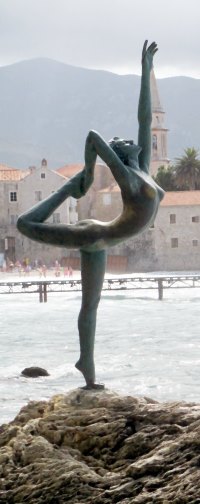PROGRAM DIES NATALIS 2015 
DAY 1 -25TH SEPTEMBER
Ø ARRIVAL IN MONTENEGRO-ALL DAY
Ø CHECK IN HOTEL SLOVENSKA PLAZA
Ø WELCOME DRINK
Ø FREE TIME
Ø DINNER
DAY 2 – 26TH SEPTEMBER
Ø BREAKFEST IN HOTEL
Ø TRANSFER TO CETINJE
Ø VISIT OF CETINJE-HISTORICAL HEART OF MONTENEGRO
Ø VISIT OF NJEGUŠI VILLAGE & LUNCH
Ø RETURN TO BUDVA
Ø FREE TIME
Ø GALA DINNER
DAY 3 – 27TH SEPTEMBER
Ø BREAKFEST IN HOTEL
Ø TRANSFER BY BOAT TO ISLAND ST NICOLA
Ø VISIT OF ST NICOLA ISLAND & LUNCH –BBQ
Ø BACK TO BUDVA
Ø VISIT OF TRADITIONAL FISHERMAN EVENT- DAY OF SIRUN WITH DINNER
link: http://www.rtcg.me/tv/emisije/ostalo/zapis/68606/zapis-dani-siruna-u-budvi.html
Ø FREE TIME
DAY 4 -28TH SEPTEMBER
Ø DEPARTURE TO AIRPORT
VISITOR GUIDE TO BUDVA
Budva is considered among the oldest on the Adriatic. The open-air stage under the open sky is located inside the walls, which offers the visitor numerous spectacles in terms of: promotion of literary works, concerts and exhibitions. Budva is today a town of theatre, festivals, holidays, beautiful hotels and beaches. You will find performed plays and symphonies on the open stage inside the Old Town at Grad Teatar, the Budva City Theater. In addition, writers from across Montenegro and the world are presented at Trg pjersnika—the Poet’s Square.
The newest parts of Budva are littered with fabulous pebbled beaches, luxurious hotels, beautiful villas and renowned restaurants. As Montenegro’s busiest tourist destination, Budva has been highly developed with a capacity for more than 100,000 tourists at a time, who are looking for an urban summer holiday in luxurious, small, family hotels or in apartments and rooms for rent.
The Montenegrin Adriatic coast is 183 miles (295km) long, with 45 miles (72 km) of pristine beaches. The most famous stretch of shoreline, however, is the Budva Riviera. This 21 mile (35km) section of coast is mountainous and in many places there is only a narrow strip of beach separating mountain and sea. There are more than 30 large beaches along the Riviera, starting from Jaz on the north to Buljarica on the south of the Municipality of Budva. Most of the beaches are divided into several parts (public or hotel beaches), offering the rental of beach equipment (parasols, deckchairs) and sports equipment (boats, paddleboats), carefully regulated in terms of the use of space and beach conduct, with an organized lifeguard service, along with many establishments offering food and drinks, and a number of small shopping outlets.
Budva is considered one of the oldest settlements in the Adriatic and is for the first mentioned in the fifth century B.C. in Sophocles’s tragedy “Oikles”. Legend says that Budva was founded by Cadmus, one of the three sons of the Phoenician king, Agenor. When Cadmus failed to retrieve his sister, Europa, who was kidnapped by Zeus, he was instructed by the Gods to build the city of Thebes. Banished from Thebes along with his wife, Harmonia, Cadmus built Budva, known in history as Butua and Budoe. A curse from the Gods, however, turned Cadmus into a dragon while out on the sea, causing he and his wife to drown together—the pair turned into fishes, holding each other by the tail to stay together, and their story lives on when shopping for souvenirs.
The most famous is Old Town Citadel built in 840. From these walls, one can gaze off into the endless marine blue of the open sea decorated with pebbled beaches and the islet of St. Nicholas, the largest islet on the Montenegrin coast. In the distance you can see the silhouette of the luxurious town-hotel at the St. Stefan peninsula, an important part of the backdrop to this picturesque town. There is fortification Đurđevac above the Old Town towards Grbalj. From Cetinje towards the sea traveler can not miss seeing a beautiful fortress above the village Brajići called Kosmač, a former Austro-Hungarian fortification from the 19th century.
With a well deserved reputation for nightlife, Budva is now established as one of the Adriatic’s leading party destinations: During the summer months, traffic on the road into town can be very slow and then you can find there is little town centre parking. Stay close in and take taxis.
Budva Citadel that juts out into the sea while the modern town is comprised mainly of low-rise condos. Very seasonal, and a tourist Mecca, Budva comes alive in the summer months. The climate in Budva is typically Mediterranean. The summers are long, hot and dry, the average temperature in July 75°F (24°C) but can go up to 90°F (35°C). The town experiences sun more than 270 days of the year and its summer season lasts from May to October. Montenegro is not yet a part of the European Union but adopted the euro as its currency in 2002.
Tourism Organisation Budva


0 comments